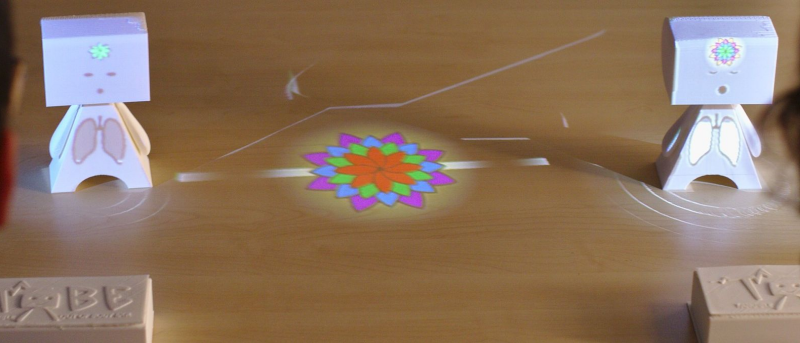TOBE is a toolkit that enables the user to create Tangible Out-of-Body Experiences, created by [Renaud Gervais] and others and presented at the TEI ’16: Tenth International Conference on Tangible, Embedded, and Embodied Interaction. The goal is to expose the inner states of users using physiological signals such as heart rate or brain activity. The toolkit is a proposal that covers the creation of a 3D printed avatar where visual representations of physiological sensors (ECG, EDA, EEG, EOG and breathing monitor) are displayed, the creation and use of these sensors based on open hardware platforms such as Bitalino or OpenBCI, and signal processing software using OpenViBE.
In their research paper, the team identified the signals and mental states which they have organized in three different types:
- States perceived by self and others, e.g. eye blinks. Even if those signals may sometimes appear redundant as one may directly look at the person in order to see them, they are crucial in associating a feedback to a user.
- States perceived only by self, e.g. heart rate or breathing. Mirroring these signals provides presence towards the feedback.
- States hidden to both self and others, e.g. mental states such as cognitive workload. This type of metrics holds the most
promising applications since they are mostly unexplored.
By visualising their own inner states and with the ability to share them, users can develop a better understating of their own selves as well others. Analysing their avatar in different contexts allows a user to see how they react in different scenarios such as stress, working or playing. When you join several users they can see how each other responds the same stimuli, for example. There are a lot of potential applications for this kind of technologies. We’ve seen it before, so why is the adoption of a clearly interesting technology so slow? Maybe when the sensors can be easily worn and non invasive we can truly see a rise people actually using this type of body sensors to enhance and improve on themselves.
Meanwhile, here’s the video with the TOBE prototypes:















Some biofeedback has value in certain domains but in general the whole field has suffered from overhype. While refreshingly, there is not much of that happening here with this device, there is also not much evidence of utility either.
Out of body experience?????
Nothing of the sort, Bodily awareness experience: Maybe.
Out of body experience is when the body and/or cerebral cortex is ignored by the conscious thought processes of the brain.
Like as though the brain has been temporarily removed from the spine/eyes/etc and the body is left to a primitive state.
Ketamine achieves this well… I’ve seen people get into right states with that stuff, I won’t touch it (or anything else psychoactive… OK maybe a tea or energy drink…. but… nothing more).
Flygaric reportedly has a more mellow effect of this. However still blanks the brain off of it’s body.
The state I’ve seen Ketamine put people in….
A lady in her early 20’s. Decent personality and ‘lively’. Also the sort to be relationship material in a town where such was impossible to find (though she was already taken… at the time). She discovered Ketamine….. Step to the future and the best description of her personality is on par with “Demonic Possession”. And she now shags everything moving, is a stick, looks unwell and doesn’t know who she is (Bearing in mind the last I met her was 1 and half years ago). This is just one person.
As far as “Crazy Women” goes, I’ll see your ketamine and raise you amphetamine.
Methyl-dymethyl, meth, or any other additional “salts” there of so to speak.
The different additions to the amphetamine group can change it’s properties (and addictiveness) pretty wildly. MDMA, AKA extacy gives a happy loved up feeling whilst “stumping the growth”, causing overheating, but not addictive (in a dependency form or not so moreish). Yet Methylated amphetamines,: addictive, aggy, they seem miserable, tired, overheating (sign of near overdose) ADDICTIVE AS FUX.
And varies there-on…
And forgot about amino groups:
Dimethyltryptamine (I pfink I spelleded that wright???) Is made in the pineal gland in the brain (naturally) but yet is the most powerful (apparently) trip (outer body, inner body, etc… Spiritual apparently)
Both should not be taken on a daily/regular base. I think occasional use is not to be considered a problem. Of course some people could have a precondition, where even occasional use can lead to a problem.
I’m glad you created this page, we need people like you who spread the message that the spiritual realm is real. We need to prepare for it. I have also had spiritual experiences including out of body’s. Please click on my name and check out my posts and hit follow. I have detailed and will continue to detail some of my experiences and even provided proof of clairvoyancy.